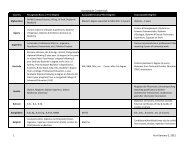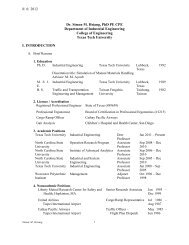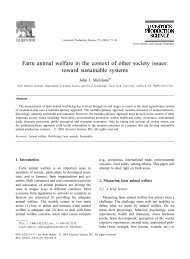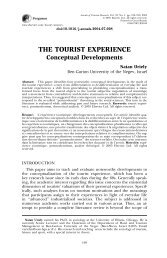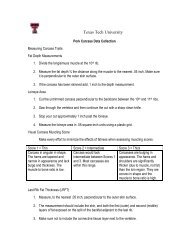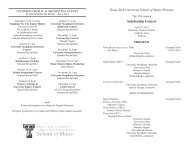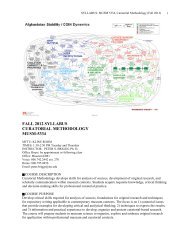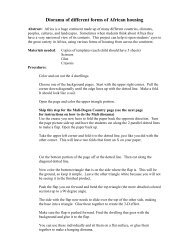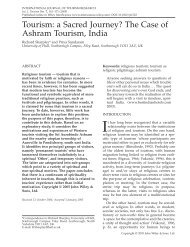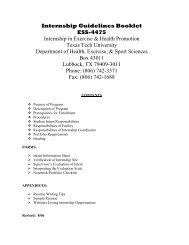Procedures for Room Numbering Standards - Texas Tech University
Procedures for Room Numbering Standards - Texas Tech University
Procedures for Room Numbering Standards - Texas Tech University
You also want an ePaper? Increase the reach of your titles
YUMPU automatically turns print PDFs into web optimized ePapers that Google loves.
PROCEDURES FOR ROOM NUMBERING STANDARDS<br />
PURPOSE<br />
o<br />
o<br />
o<br />
Identify and assign numbers to individual spaces in university buildings.<br />
Provide location in<strong>for</strong>mation <strong>for</strong> university employees, students, visitors and emergency responders.<br />
<strong>Room</strong> signage must be fixed, tamper resistant and in compliance with ADA regulations. Refer to OP<br />
61.20 <strong>for</strong> additional in<strong>for</strong>mation.<br />
OVERVIEW<br />
1. These procedures outline the room numbering conventions to be used at <strong>Texas</strong> <strong>Tech</strong> <strong>University</strong>.<br />
Although they should be easily applied to most projects, logical discretion must be used to effectively<br />
apply these conventions. Care must be taken, and adequate review is built in, to ensure the exception does<br />
not become the rule.<br />
2. Definitions:<br />
o Main Entrances are outside door openings into a building accessible to the public.<br />
o Hallways / Corridors / Vestibules / Lobbies are defined as circulation areas accessible to the<br />
public.<br />
o Custodial/Building Service <strong>Room</strong>s are building service rooms controlled by Custodial Services.<br />
o Mechanical / Electrical <strong>Room</strong>s are building service rooms controlled by Physical Plant Services.<br />
o Restrooms are designated <strong>for</strong> use by Men / Women / Unisex or Private.<br />
o Stairways that are inside the building are given a number <strong>for</strong> identification.<br />
o Telecommunication <strong>Room</strong>s are rooms that house networking equipment controlled by<br />
Telecommunication services<br />
o Closets are numbered according to the room they are attached to using an alphabetic designation.<br />
o Chases are inaccessible spaces built inside a building to house mechanical equipment or wiring.<br />
o Suites are a series of attached rooms with a primary room that has entrance from a corridor. The<br />
primary room is numbered and the interior rooms, in a logical manner, adopt that number plus an<br />
alpha suffix.<br />
o Connecting/Adjacent <strong>Room</strong>s are rooms or suites joined by a shared door, all of which have a<br />
hallway entry.<br />
o Individual <strong>Room</strong>s have four walls with a hallway entry.<br />
o <strong>Room</strong>s with Partial Walls or Counter Space should be numbered within the larger space.<br />
o Cubicles are furniture and not defined as rooms and will not be numbered.<br />
o Study Carrels may be given an alphabetic suffix following the room number the carrel is housed in,<br />
depending on design intent.<br />
3. Some buildings are designed in such a manner that different wings or sections exist within the overall<br />
structure. In such a case, the design professional may designate the wing or section with a unique<br />
character such as Tower A/Tower B, or wings “E” <strong>for</strong> east, “W” <strong>for</strong> west, etc.<br />
4. If cardinal directions (i.e. compass directions; north, south, east, west) are used, care must be taken to<br />
ensure they are the actual directions and not the orientation of the plans on the paper space.<br />
Attachment, pg. 1<br />
OP 61.21<br />
7/24/13
ROOM NUMBER ASSIGNMENT STEPS:<br />
1. Determine location of main entrance<br />
a. Although there will be several entrances to any building, there is one that by design is considered the<br />
main entrance. This must be identified and will serve to maintain coherence to the numbering pattern<br />
(see figure 1).<br />
Alternate Entrance<br />
Main Entrance<br />
Figure 1<br />
Main Entrance Identification<br />
2. Determine numbering start point<br />
a. First floor<br />
i. From the main entrance, follow a natural pedestrian footpath inside the building to what is<br />
considered the far left end of the building. The room numbering sequence will begin at this<br />
point (see figure 2).<br />
Main Entrance<br />
Figure 2<br />
Start Point Identification<br />
Attachment, pg. 2<br />
OP 61.21<br />
7/24/13
. Floors above and below first floor<br />
i. Follow the same numbering pattern established on the first floor. It is important to note that<br />
this is without regard to the location of stairs and elevators. The numbering start point <strong>for</strong><br />
each floor must vertically correspond to the start point on the first floor.<br />
3. Assign room numbers on first floor<br />
a. Once the start point is identified, begin numbering the rooms. Number rooms sequentially beginning<br />
at the start point and proceeding to the other (right) end of the building.<br />
b. Odd numbered rooms will be on the right side of the hallway, even numbers will be on the left.<br />
Unique rooms (e.g. restrooms, hallways, mechanical, etc) will be numbered in the order they are<br />
encountered.<br />
c. The room number <strong>for</strong>mat is arrayed in four main fields (wing, floor, room, and additional identifier).<br />
Wing is a single character; floor, room, and additional each have two characters <strong>for</strong> a total of seven.<br />
Wing, floor and room are mandatory and must be zero filled if not used. Additional fields are left<br />
blank if not used (see table 1). Floor number assignment is logical, intuitive and corresponds to the<br />
actual floor number (see table 2). Examples of complete room numbers are shown in table 3.<br />
d. If a large room exists, skip a number immediately preceding or following the room to allow <strong>for</strong><br />
future expansion. This will not disrupt the way-finding characteristics of the system.<br />
e. If suites are used, alphabetically designate the far left room in the suite as “A” and follow a left to<br />
right, logical progression <strong>for</strong> the additional interior rooms.<br />
f. For connecting/adjacent rooms, number each one separately according to hall access order.<br />
Table 1<br />
<strong>Room</strong> Number Format<br />
Wing<br />
Identifier<br />
Floor #<br />
Identifier 1<br />
Floor #<br />
Identifier 2<br />
<strong>Room</strong> #<br />
Identifier 1<br />
<strong>Room</strong> #<br />
Identifier 2<br />
Additional<br />
Identifier 1<br />
Additional<br />
Identifier 2<br />
X X X X X<br />
MANDATORY<br />
(zero fill if not<br />
used)<br />
MANDATORY<br />
(zero fill if not used)<br />
(see table 2)<br />
MANDATORY<br />
(zero fill if not used)<br />
OPTIONAL<br />
(leave blank if unused)<br />
Table 2<br />
Floor Identifier Examples<br />
Floor<br />
Sub-basement<br />
Basement<br />
First<br />
First Mezzanine<br />
Second<br />
Tenth<br />
Second Mezzanine<br />
Fifteenth<br />
Floor Identifier<br />
xSBxx_ _<br />
x00xx_ _<br />
x01xx_ _<br />
xM1xx_ _<br />
x02xx_ _<br />
x10xx_ _<br />
xM2xx_ _<br />
x15xx_ _ _ __ _<br />
Attachment, pg. 3<br />
OP 61.21<br />
7/24/13
Table 3<br />
Examples of Completed <strong>Room</strong> Numbers<br />
East Wing, First Floor, <strong>Room</strong> 121 -- B<br />
Wing<br />
Identifier<br />
Floor #<br />
Identifier 1<br />
Floor #<br />
Identifier 2<br />
<strong>Room</strong> #<br />
Identifier 1<br />
<strong>Room</strong> #<br />
Identifier 2<br />
Additional<br />
Identifier 1<br />
Additional<br />
Identifier 2<br />
E 0 1 2 1 B<br />
East wing First floor 21st room on floor Second room in suite<br />
Sub-basement, room 18<br />
Wing<br />
Identifier<br />
Floor #<br />
Identifier 1<br />
Floor #<br />
Identifier 2<br />
<strong>Room</strong> #<br />
Identifier 1<br />
<strong>Room</strong> #<br />
Identifier 2<br />
Additional<br />
Identifier 1<br />
Additional<br />
Identifier 2<br />
0 S B 1 8<br />
No wing ID Sub-basement level 18 th room on floor Not part of a suite<br />
Second Floor, hallway 1<br />
Wing<br />
Identifier<br />
Floor #<br />
Identifier 1<br />
Floor #<br />
Identifier 2<br />
<strong>Room</strong> #<br />
Identifier 1<br />
<strong>Room</strong> #<br />
Identifier 2<br />
Additional<br />
Identifier 1<br />
Additional<br />
Identifier 2<br />
0 0 2 H 1<br />
No wing ID Second floor<br />
Initial hallway<br />
originating at start<br />
point<br />
Not part of a suite<br />
Attachment, pg. 4<br />
OP 61.21<br />
7/24/13
g. Specialty rooms<br />
i. In the event any of the room types listed in table 4 exist in the building, number them with<br />
the unique character in room # identifier 1.<br />
ii. Number room identifier #2 in numerical order, originating from the start point by type of<br />
specialty room. For example, the first hallway from the start point is x01H1_ _, the second<br />
hallway section is x01H2_ _, et cetera (see figure 6).<br />
Table 4<br />
Specialty <strong>Room</strong> Designation<br />
Unique character<br />
H<br />
C<br />
E<br />
S<br />
T<br />
R<br />
U<br />
M<br />
Definition<br />
Hallways / Corridors / Vestibules / Lobbies<br />
Custodial/Building Services<br />
Elevator<br />
Stairways<br />
Telecommunications<br />
Restrooms<br />
Chase<br />
Mechanical <strong>Room</strong><br />
4. Assign room numbers on subsequent floors<br />
a. The same process is followed as in 3 above. Ensure the start point is immediately above or below the<br />
start point on the first floor. This will help ensure all floors are numbered in a similar manner.<br />
Attachment, pg. 5<br />
OP 61.21<br />
7/24/13
NUMBERING PICTORAL OVERVIEW<br />
Alternate Entrance<br />
Main Entrance<br />
Figure 3<br />
Identify Main Entrance<br />
Main Entrance<br />
Figure 4<br />
Identify Start Point<br />
Attachment, pg. 6<br />
OP 61.21<br />
7/24/13
Start point<br />
Numerical Progression<br />
Main Entrance<br />
Figure 5<br />
Direction of Numerical Progression<br />
Even numbers on the left<br />
Specialty rooms numbered in<br />
order encountered from start<br />
point<br />
Start<br />
Odd numbers on the right<br />
*Note large room number skip<br />
Main Entrance<br />
Figure 6<br />
General <strong>Room</strong> <strong>Numbering</strong> Pattern<br />
Attachment, pg. 7<br />
OP 61.21<br />
7/24/13
Suite alphabetic designation—<br />
rooms within those with<br />
alphabetic designation would<br />
use additional identifier 2<br />
Main Entrance<br />
Figure 7<br />
Use of Additional Identifiers<br />
Actual room numbers<br />
(samples)<br />
00102 00104 001R2 001H2 00108A<br />
Figure 8<br />
Completed <strong>Room</strong> Numbers<br />
Attachment, pg. 8<br />
OP 61.21<br />
7/24/13



